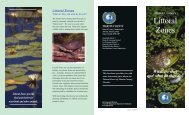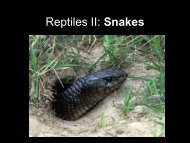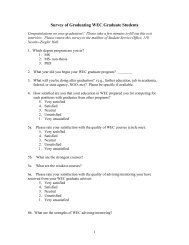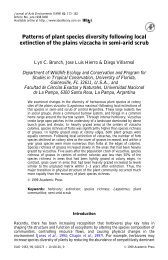Florida Cooperative Fish and Wildlife Research Unit
Florida Cooperative Fish and Wildlife Research Unit
Florida Cooperative Fish and Wildlife Research Unit
- No tags were found...
You also want an ePaper? Increase the reach of your titles
YUMPU automatically turns print PDFs into web optimized ePapers that Google loves.
FLORIDA COOPERATIVE FISH AND WILDLIFERESEARCH UNIT INTRODUCTIONThe <strong>Florida</strong> <strong>Cooperative</strong> <strong>Fish</strong> <strong>and</strong> <strong>Wildlife</strong> <strong>Research</strong> <strong>Unit</strong> was established in 1979 as one of the first combinedunits. The purpose of the <strong>Florida</strong> <strong>Unit</strong> is to provide for active cooperation in the advancement, organization, <strong>and</strong>conduct of scholarly research <strong>and</strong> training in the field of fish <strong>and</strong> wildlife sciences, principally through graduateeducation <strong>and</strong> research at the University of <strong>Florida</strong>. The <strong>Florida</strong> <strong>Unit</strong> has the mission to study wetl<strong>and</strong> ecosystemswithin the state. <strong>Florida</strong> is a low relief, sub-tropical peninsula that is ecologically fragile. Though abundant,<strong>Florida</strong>’s water resources are under increasing pressure from a burgeoning human population. Domestic, recreational,<strong>and</strong> development needs threaten <strong>Florida</strong>’s water / wetl<strong>and</strong> resources. In following its program directive, the <strong>Florida</strong><strong>Unit</strong> has developed a research program, that addresses management issues with approaches spanning species toecosystem perspectives. Specifically, this <strong>Unit</strong> conducts detailed investigations of aquatic-terrestrial ecosysteminterfaces <strong>and</strong> their component fish <strong>and</strong> wildlife resources.Between 1979 <strong>and</strong> 2008, over 297 projects totaling more than $42.8 million were funded through the <strong>Unit</strong>. Theseprojects covered a wide variety of fish, wildlife, <strong>and</strong> ecosystem subjects <strong>and</strong> have involved 49 line, affiliate, <strong>and</strong>adjunct faculty members as principal <strong>and</strong> co-principal investigators. <strong>Unit</strong> staff have their own research projectswhich accounted for about 1/3 of the total effort. Projects associated with the <strong>Unit</strong> have resulted in 389 publications,104 technical reports, 89 theses <strong>and</strong> dissertations, <strong>and</strong> 155 presentations. Cooperation has been the <strong>Florida</strong> <strong>Unit</strong>'sstrength. As a <strong>Cooperative</strong> <strong>Research</strong> <strong>Unit</strong> of the U.S. Geological Survey, serves as a bridge among the principalcooperators, such as the University of <strong>Florida</strong>, the <strong>Florida</strong> <strong>Fish</strong> <strong>and</strong> <strong>Wildlife</strong> Conservation Commission (FFWCC),the U.S. Geological Survey (USGS), the U.S. <strong>Fish</strong> <strong>and</strong> <strong>Wildlife</strong> Service (FWS) <strong>and</strong> the community of state <strong>and</strong>federal conservation agencies <strong>and</strong> non-governmental organizations. Evidence of this role is the <strong>Unit</strong>'s fundingwhich has included contributions from FFWCC, 12 BRD research labs <strong>and</strong> centers, 12 offices within the USFWSSoutheast Region, the University of <strong>Florida</strong>, U.S. Army Corps of Engineers, U.S. Navy, U.S. Department ofAgriculture, U.S. Air Force, U.S. National Park Service, Environmental Protection Agency, St. Johns River WaterManagement District, South <strong>Florida</strong> Water Management District, U.S. AID, World <strong>Wildlife</strong> Fund, The NatureConservancy, National Marine <strong>Fish</strong>eries Service, National Oceanic <strong>and</strong> Atmospheric Administration, BRD, <strong>Florida</strong><strong>Wildlife</strong> Federation, National Audubon Society, <strong>Florida</strong> Alligator Farmers' Association, American AlligatorFarmers' Association, <strong>Florida</strong> Fur Trappers' Association, <strong>and</strong> other private contributions. Many <strong>Unit</strong> projectsinvolve multiple investigators from several agencies. This cooperative interaction stimulates continuinginvolvement of funding sources, provides for student contacts with potential employers <strong>and</strong> agency perspectives,<strong>and</strong> directs transfer <strong>and</strong> application of research results.5


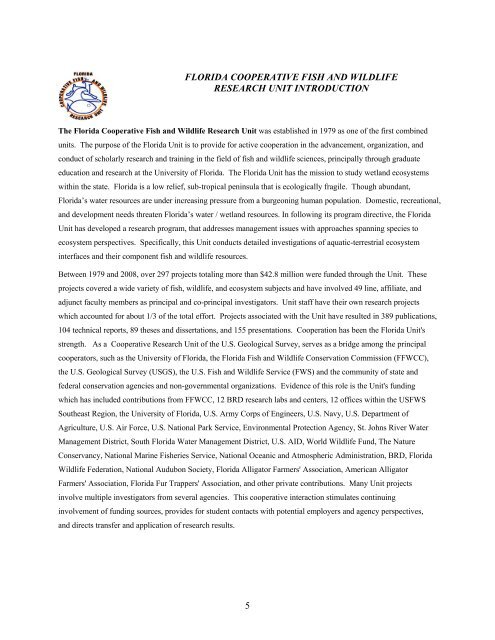
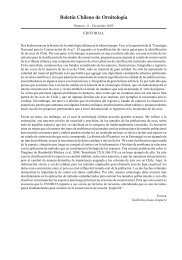
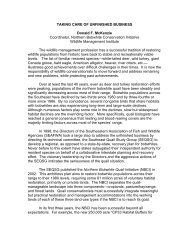
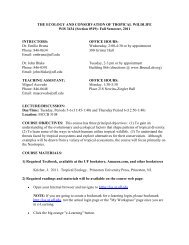
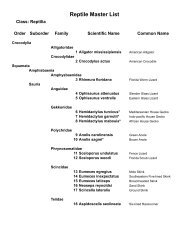

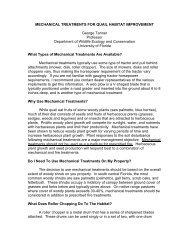
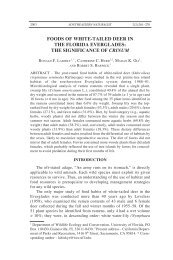
![rivers,lakes.ppt [Read-Only]](https://img.yumpu.com/43445703/1/190x245/riverslakesppt-read-only.jpg?quality=85)
